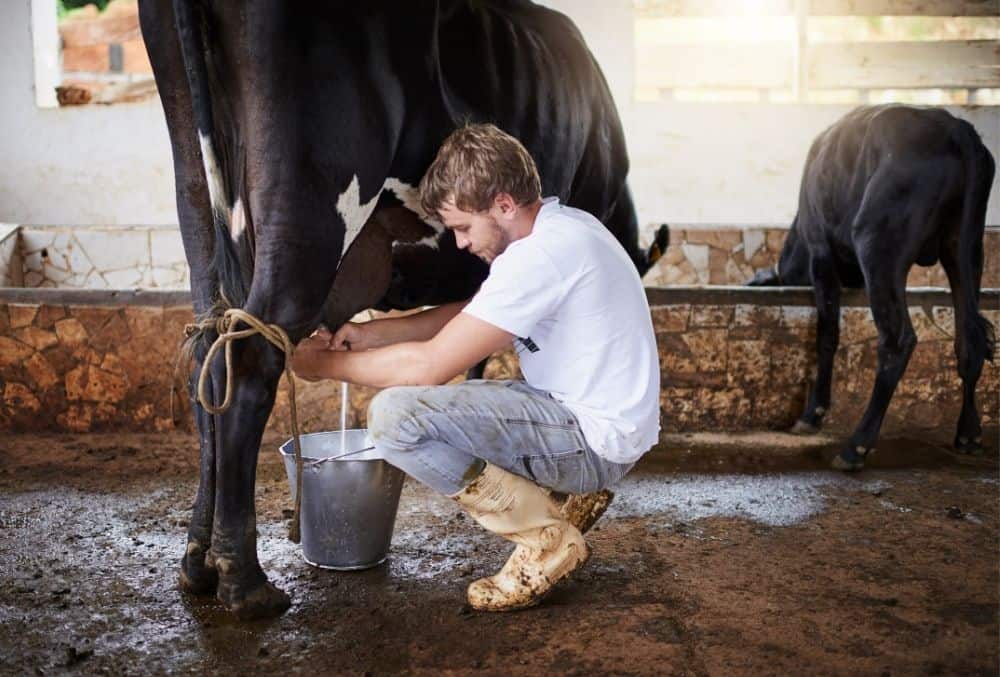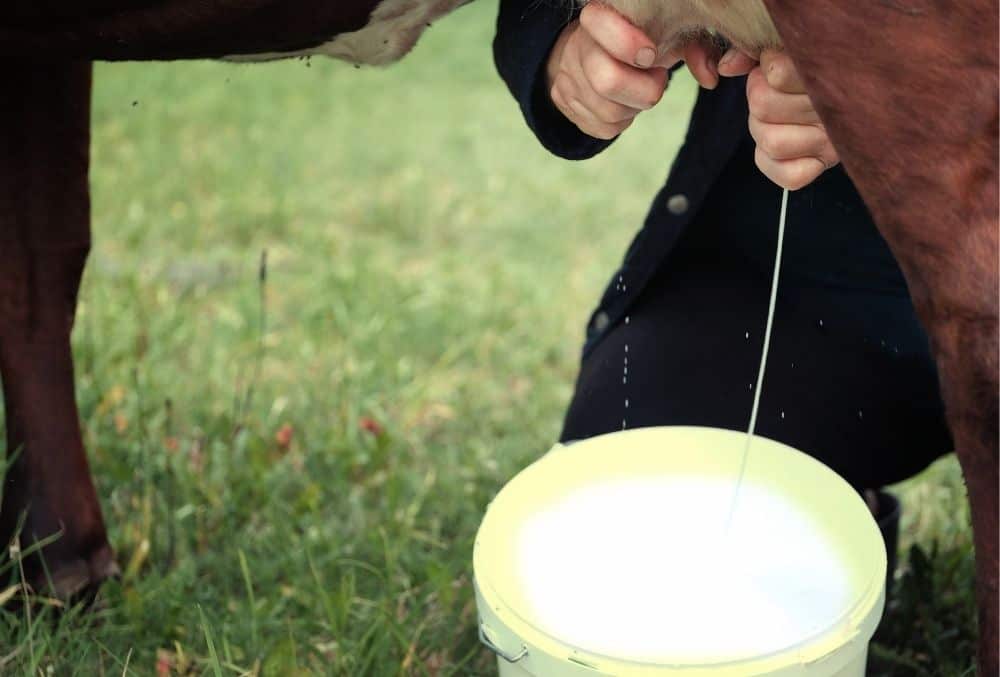Having your own cow can easily make your household self-sufficient. Milk is used in a variety of recipes. Many people enjoy having milk poured on their morning cereal or in their coffee.
Not only that, but it has many health benefits. For instance, milk is high in protein and calcium. In addition, milk can be great for your bones.

If you have the space and resources to look after your own cow, it can really benefit you to do so. However, some people may be put off looking after a cow since they do not know how to milk one. To prevent this from being an issue, we have explained the process of milking a cow in great detail.
Though many farmers use machines to milk their cows, most people will not have access to this. Therefore, you will have to hand milk the cow. This can be a time-consuming endeavor, though it will be worth it when you get loads of milk.
Equipment
- Gloves – these will protect your hands. When you are milking a cow, you will have to touch some intimate parts of the animal. Wearing gloves will prevent you from picking up harmful bacteria.
- Bucket – a bucket will be used to collect your cow’s milk. This will need to be a fairly large bucket. It will also need to be clean and sterile.
- Cloth or paper towel – when washing a cow’s teats, it is crucial that you dry them. As a result, a clean cloth or towel will come in handy.
- Iodine dip – this will be used in the cleaning process. It is worth investing in these if you plan on keeping a cow. Iodine dips can be bought online for fairly inexpensive prices.
- Storage jars – once you have obtained the milk, you will need to find a vessel in which to store it.
- Strainer – a strainer will be used to ensure that nothing unwanted gets into the final product.
- Rope (optional) – can be used to stop a cow from escaping or moving about too much.
- Stool (optional) – you can perch on this while you are milking the cow if you so desire.
How To Milk A Cow

- Make sure the cow is securely in place. This will prevent it from moving around while you are milking it. If you have a spare piece of rope, feel free to tie your cow to a post.
- Be gentle with the cow. If you seem aggressive toward your cow, it will react negatively. Milking a frightened cow will be difficult. Instead, try to make your cow as calm and relaxed as possible. Milk them in a comfortable space. If they seem nervous, consider giving them some food to nibble on.
- Clean your cow’s teats. Washing is a crucial step because otherwise milk can become corrupted by bacteria. Naturally, your cow will become dirty. Wash this area with an iodine dip. Iodine is effective for sanitizing your cow’s teats. You can also use water, though this could weaken your cow’s milk.
- Once they have been cleaned, dry them off with a cloth or paper towel. Do this in a gentle fashion, as this area will be very sensitive for your cow.
- Begin stripping each of the teats. For those of you who do not know, stripping is the act of pulling at the teat to get rid of any residue milk. This will allow you to see if the milk looks as it should. Do not collect this milk. If the milk does not look right, such as if it is discolored, you should not milk your cow. Instead, you should get it examined. This is because your cow could have mastitis, a bodily response to some form of infection.
- If your cow’s milk is healthy, you can proceed. To continue, place a clean bucket directly underneath your cow’s teats. If you are able to, hold this bucket in place with your legs. This will prevent it from accidentally being knocked over. Otherwise, you could end up losing some of your milk.
- Sit beside your cow. You will need to be very close to the cow in order to properly milk it. Though it may seem intimidating to get up close and personal with a cow, it will be more painful if it kicks you from afar. If you want extra leg support, feel free to bring a stool with you.
- Gently squeeze one of your cow’s teats. Put your thumb at the top of your cow’s teats and the rest of the fingers below. This will allow you to cup the teats. Slowly squeeze the teats with your hands moving in a downwards direction. Milk should begin coming out.
- Repeat this step for all four teats.
- After you have acquired all the milk, clean the teats again. You should also use iodine for this.
- Filter the milk that you have collected. Transfer the milk from your bucket into jars in which it can be stored.
- Sanitize any equipment you used in the milking process. If you have disposable gloves, be sure to throw them in the bin. If they are multi-use gloves, clean them thoroughly. After this, the equipment is ready for the next time you need to milk your cow.
- Enjoy your delicious milk!
Frequently Asked Questions
How Often Should You Milk A Cow?
This will be somewhat dependent on your lifestyle. However, many farmers will milk their cows multiple times a day. It is common for them to do it at least two or three times each day.
What Will Happen If You Don’t Milk A Cow?
Neglecting to milk a cow that requires milking will be bad for its health. If it goes for a long period without milking, it could become seriously ill and will experience a lot of pain. As a result, you should ensure that you milk your cow often.
Do Cows Enjoy Being Milked?
A cow will likely feel a sense of relief once they have been milked. However, if done incorrectly, milking can be a painful process for them. Consequently, please be soft when you are milking a cow.
